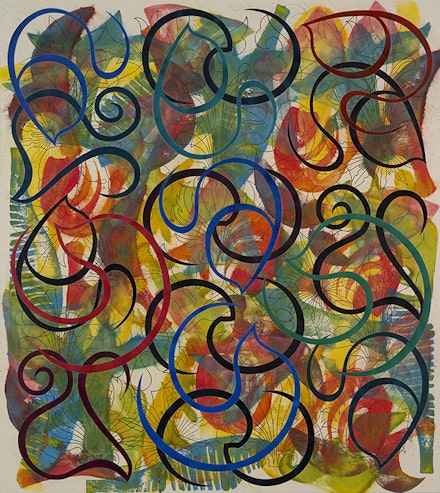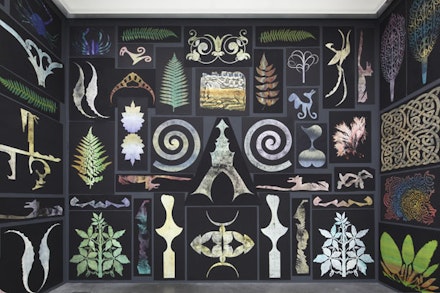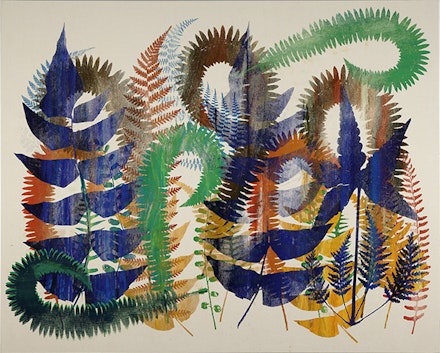Critics Page In Conversation
PHILIP TAAFFE with Charles Stein
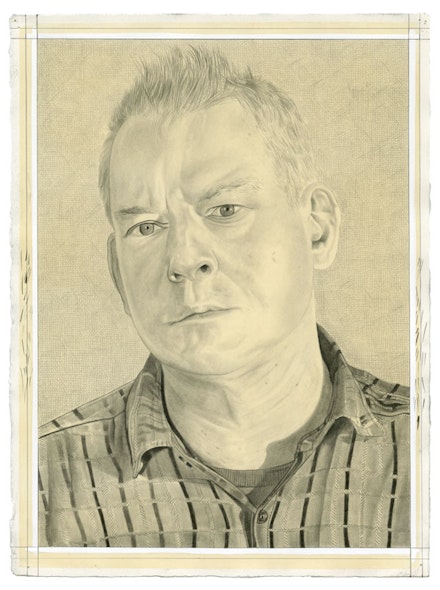
Since the 1980s Phillip Taaffe has been forging a distinct visual language of density and delight, mining the history of forms to create layered, optically charged paintings. Exhibited widely, in 2008 the Kunstmuseum Wolfsburg organized a retrospective survey The Life of Forms in Art: Paintings 1980–2008. Luhring Augustine will begin the year with an exhibition of new works in their Bushwick gallery (January 17 – April 26, 2015) which coincides with the celebration of artist’s 60th birthday. Taaffe met with Charles Stein—the eminent American poet, musician, and classicist—to discuss the intricacies of his process and recent images in all their richness and complexity.
Charles Stein (Rail): When you eventually arrive at what you want to have in a painting, is the number of elements something that is decided beforehand, or is it arrived at through the process?
Philip Taaffe: It’s arrived at along the way. Number is important to me, and variation is important to me, as are the interior analogies within a work—how elements correspond in different parts of the work. I discover connections in the course of making the work. I build that into the work, so these discoveries get constructed into the picture itself. The wonderful thing about collage is that a lot of the elements on paper can be put in different places and later removed. I can lay everything out on the floor and figure out what’s going on, and decide what to permanently apply to the work. I work in an elliptical way in that respect, an indirect way, as far as mark-making. It can be a mark if I want it to be, but then that mark can be erased. In the course of working on a painting what I leave out is as important as what I put in. There are all kinds of levels of intentionality within a work, and collage allows me to keep my options open during the working process.
Rail: When you choose the elements, I presume it is for visual reasons, that is to say formal, as as well as symbolical ones: what the images represent. But how much of this concern is worked out beforehand? Once chosen, how much are you allowing these images to come to significance on their own?
Taaffe: It has to make narrative sense in my mind. Often there are certain historical and geographical themes that can be brought together. For example, in “Onibaba I” (2011), I wanted to work with Japanese Noh masks. And I wanted to have these bronze lanterns and carved screens function as the enveloping network of lines behind the masks. Then I saw Kaneto Shindo’s film Onibaba (1964), a Japanese ghost story, and it made a tremendous impression on me. It was a great primal film experience, and I wanted to capture some aspect of that: echoes, reverberations. I used Shindo’s title because it’s always interesting to know what people are inspired or influenced by, but there is no direct correlation necessarily. Sometimes I choose to associate myself directly with a work of art like that—it’s good back-up in a sense. I wanted to make this strong reference to an experience I had. It seemed something worthy to aspire to, in terms of an expressive goal.
Rail: There is a simultaneous revealing and concealing of the laborious intensity behind the work, even where the subject matter seems to be ornament as such. What people see as “decorative” often involves concrete reference to ornamental forms and contexts.
Taaffe: It’s the specificity of it that really matters. For example, when I discovered this illustrated field report on the Mongolian canoe decorations of the Amur tribe, that was a real shock of recognition for me. I’m identifying a historical and geographical crystallization of culture—a certain visual trope that can transport me somehow in the making of a work. I always feel that I’m a medium. My ideal condition is to be outside of the work and to let these transmissions take place on the basis of my understanding and personal reflections and my urge to turn these tropes into something that is of palpable use, through my physical actions and gestures, through signs and traces—all of the things I can build upon and make connections from. I think that an artist has to set up imaginary fields of possibility for the participant, the viewer, to help them connect with their own personal history, their own humanity, where they come from. That’s the dialogue that art provides. It’s how we carry on.
Rail: There are many languages of ornament. What is often at stake is the fact that your work does allude to the ornamentation of not only art, but of architecture and functional things like grates and fences, lifted from specific historical and cultural contexts. And these contexts may include the old books from which you have adapted or derived the images. The images also often have an emblematic character. There is thus an emblematic itinerary—a journey of images, glyphs, symbols, across different stations in historical time, that terminates at your picture. At the same time there is also a kind of “decorativeness” in your practice in the sense that abstract shapes are arranged in ways that are in themselves simply beautiful. They give pleasure by how they look, not necessarily different from the way that ornamentations or decorations do. The surface is beautifully ornamented while at the same time alluding to specific ornamental realms. So there is a complexity to the meaning of the decorative in these works that goes well beyond the usual objections to the merely decorative. There is also a rhetoric of emblems and glyphs that is in another sense something quite different from an arrangement of “ornaments.” They suggest a particular plane of registry, a register of the emblematical, parallel, say, to the plane of the pictorial. Floating on the frontmost surface of the work is a region where emblems float in their own realm.
Taaffe: Well, these paintings are in part historical meditations. When I place glyphs that have been used by people in a certain time and geographical place, it’s a kind of time-traveling. I’m unraveling a kind of narrative, bringing in certain disputed narratives, and weaving them back together—that’s something that I very much like to do. In that sense my work is about desire, ultimately. Painting is about what I want to exist in the world. I feel there’s a certain kind of tonality and poetry and sensuousness that is missing, perhaps, from our time. So I’m trying to bring into the world something I don’t believe exists in this way. If people want to call that “decorative” then that’s their problem. I don’t mind, just as Matisse didn’t care that his paintings were thought of as decorative. The difference between the decorative and other aspects of the composition to his mind wasn’t a determinate distinction. The problem with what we’re getting into here is the shifts of tendencies in Modernism, and how there are academic critics who want to blot out the possibilities of a given history—a given color, a kind of music.
Rail: Speaking of which: do you listen to music while you work?
Taaffe: Sometimes, it depends on the stage the work is in. When I get stuck on a painting and I don’t know where to take it next or I’m working out some complex structure within a work, I listen to Mozart, the marches. Somehow, they just snap me to attention, enable me to get to the bottom of things, the heart of the matter. Often I find old records that no one wants and that I’ve never heard of, and I’ll give them a listen to. Recently I discovered Peter Warlock this way, on the flip-side of a Benjamin Britten recording. I’d never heard of Peter Warlock. His real name was Philip Heseltine. He was a British musicologist, and had a deeply scandalous life. I started listening to this piece of his and I really loved it. The “Capriol Suite” is based on 18th-century French choreography. He’s someone who studied antique musical forms and made something new out of them. When I heard this composition and researched his work, I realized why I liked it. I like studying older paintings or older music and then culling something that I feel is unspoken, something that I can build upon—rhythms and variations. Encountering a visionary work can be inspiring no matter what medium, because you connect to that vision, it helps you to focus. Inspiration isn’t necessarily like, “I’m going to take this and put it in a work,” rather it’s a kind of attitude or approach. Music is conceptually not unlike collage in that there are a certain set number of elements that you can use to create something. I guess I like that stricture. I like the discipline. I like going into a limited group of possibilities and making a world out of it. I like that sense of being resourceful. And I believe it has environmental and economic implications.
Rail: How does color function for you in all of this?
Taaffe: I think the color has to emerge from the emotional atmosphere of a work. At a certain stage in the making of a work the subtle tints that accumulate over the entire surface of the work bring about a unified experience. It has to do with the feeling-state of the painting. That’s how I would put it. The colors have to do with the specifics of the painted experience. I like Matisse’s claim that the best color is always dirty color, when there’s something inside the color that’s messy.
Rail: In Matisse, the cut-outs were about immediacy and grace; you are about grace but with mediation. The mediation of a historical itinerary which complexifies the pleasure.
Taaffe: I like to use the term “adequacy” to describe the goal in view as I develop a piece. At a certain point in working over the many stages of these paintings, I have to remind myself what it is I hope to achieve. The answer in general is that I hope to achieve a level of adequacy: sufficient for the specific requirements of the work, a sense that this is all that is necessary. I’m not fussing over it. It’s adequately presented. That’s an important methodological principle for me. It doesn’t mean I’m settling for less. It’s what it needs to be, given the materials that I wish to bring together in a work. A painting is an enclosure for a circuit of energy. Lots of things are connected and held in place by the format of the work itself. The edge is clearly important to me in terms of how the energy is held in place. One thing I try to avoid is a fragmentary pictorial experience. I like the works to be fully contained and fully realized, which requires a certain amount of compositional adjustment in the making. I make a lot of material and use it towards one painting, and explore that theme in depth, as opposed to spreading it out over a number of works. I don’t really work in series, so when I do an exhibition in a gallery, each painting will be thematically quite diverse. But there is a thread between them somehow.
Rail: It would be adequacy in terms of what you had already proposed to do. So the other side of that would be that you are proposing something that is not compromising.
Taaffe: It’s always something that doesn’t seem quite feasible at the outset. By now, painting for me seems like quite a long and epic involvement. Each picture is a long journey. Moving forward is like a wheel revolving, it goes forward but it comes back around—there’s always a retrospective aspect to it. I don’t discard any of my earlier imagery. There are a lot of earlier concerns continuing: iconography, glyphs, fantastic architecture. I don’t close any doors behind me. I always try to expand upon what I have done, and add to it. It’s all about the fullness of incident: trying to tell a complete story. What I’m really interested in is a larger synthesis—that’s what I try to achieve. I always try to find a way of adding things that I think belong there thematically and symbolically, from the standpoint of gesture and incident—what ultimately manifests into a pictorial phenomenon. I think more is better, and I think it’s very important to try to incorporate as much as possible. But then there’s a lot of editing involved in making my work, a lot of process, a lot of research. I have to tell some sort of pictorial story on the basis of all of these concerns and gestures.
Rail: But the evidence of your hand in these pictures often seems distant from the images themselves. Does this have something to do with the mechanical techniques used to create them?
Taaffe: I wouldn’t use as strong a word as “ideological,” but there is something about the analysis of my own “voice” and my desire to be removed from the work, which these mechanical techniques somehow facilitate. There’s certainly a psychological struggle going on there, in terms of those kinds of decisions. I want to be more of a mediator than an actor. There’s the original creative impulse, and then later there’s the self-consciousness or self-awareness of that impulse. Juggling these states is a game one plays with oneself in the work.
Rail: There’s an intense paradox, vis-à-vis this hands-on-ness, because you’ve removed some of that directness by changing the scale of some of the images you’ve used, such as the enlargements from microphotography. One has no idea of what the actual size of these things are, so the similarity between them and the way you have treated them volumetrically and coloristically are not interfered with by differences of scale. In the painting, you’ve brought them all into the same scale. And the change in scale also is how they become more generalized and abstract. The treatment in the printed image is on the way to abstraction, and you carry them further in the process by disengaging from the specificity of the scale.
Taaffe: As to the distancing, I like the fact that my own process is hidden or understated. I don’t like gratuitousness: gesture for the sake of gesture. I don’t like to do things I don’t have to do within the painting, but there are many things I feel I must do outside the painting. In preparing imagery for example, I have produced tusche silkscreens which are hand drawn onto the silk with a grease crayon. They’re incredibly labor intensive, but the labor is not evident. Other images are relief-printed from linoleum carvings, but made in such a way that they’re gossamer like—they’re phantasmic. The decision to reduce the opacity of the prints, knowing that one would be able to see through them, was entirely intentional. That was a measured treatment. There’s also a lot of in-painting, a lot of going back and re-touching, but you don’t see the evidence of it. But I don’t need to show all of this. I’m showing the world something else.
Rail: You say you don’t want to do any more work than you have to, but you follow by saying the silkscreens are hand drawn, which is highly labor intensive. There’s a paradox here.
Taaffe: Yes, the paintings are very much made up of paradoxes. There’s ambivalence and there’s clarity, and each has its place. The fact that all of these different renderings and approaches are combined is what puts the painting into the realm of abstraction.
Rail: The superimposition of different content, different pictorial planes, different possible cultural and historical references, different rhetorical registers—is not only spatial, then, it’s temporal—different phases of waiting or gestating, superimposed in their consequences.
Taaffe: In my work the labor is never really restrictive or eliminative. It allows for a deepening, a discovery of qualities. There is no universal demand. In fact, I develop different procedures for each work. I never generalize or formalize them. I’m not making a strict agenda, I’m suggesting openness, and a state of natural abiding.
Rail: The images in your work are applied in discrete series of operations, sometimes separated by extended intervals of time. These intervals are significant in that the accumulation of reflection between the applications of the various layers is the mysterious site, as it were, where the intuited relations between images and layers are allowed to accumulate and suggest the details of their final form. The picture becomes a receptacle not only of the images and their sources, but of the invisible spiritual activities performed during these periods of waiting.
Taaffe: It’s about arriving at a point of objective realization, then you go on to the next stage, to another state of realization. But one cannot proceed without the certain degree of closure that has occurred at the end of the previous phase. That has to be brought to a point of resolution before the next phase can commence. Not only are there imagistic layers but there are deliberative layers. Painting for me is a considered process that is made up of observation and deliberation, and I’m inviting the viewer to participate in this process. Deliberation is important because it has cultural consequences. We need to have an awareness of the consequences of our actions, to be more deliberative in a cultural sense, and not be in this state of constant inattentive, distracted activity. That is what I mean when I say I try to avoid a fragmentary pictorial experience. Granted, this is all a very far-reaching notion, but I still think art should be paradigmatic—it should suggest a way of living. I still believe in the moral standards of artistic creation: that the painting can have implications beyond itself.
Rail: I’ve been thinking about the primordial in your work—something that started to form in my mind when I was reading through your interview with Stan Brakhage in the Composite Nature book. There is a poem of Charles Olson’s in the second volume of the Maximus Poems that ends:
The sea does
contain the beauty I had looked at
until the sweat
stood out in my eyes. The wonder is
limitless, of my own term, the compound
to compound until the beast rises from the sea.
Taaffe: Astonishing. What is that “beast”?
Rail: Throughout the Maximus Poems there’s a history of the migratory journey of Olson’s heroic figure, Maximus—who takes on the identities of different personages from literary archaic personages to, say, John Smith, the British explorer, and finally Olson himself. But Maximus is always accompanied by a kind of dragon or sea-serpent, and it is this sea-monster that Olson is trying to see.
Taaffe: He is trying to see the primordial.
Rail: To bring it up into view. It has to do with the relationship between the primordial and the dangerous—a struggle with the hidden depths—that is brought to bear in a way that manifests as beauty. It is not the post-Kantian sublime. It is not something that is constituted in contrast to or even in excess of the rational. Though of course, it isn’t particularly “rational” beauty either in a classical sense. The beautiful is already outside that consideration because of the intensity of its experience. It is a difficult beauty, a beauty borne of the intensity of a struggle, an unflinching looking into the primordial, risking being turned to stone, choosing to do the impossible thing and being willing to remain with it until it yields to vision.
Taaffe: How long can we remain there is the question. Subliminal beauty is dangerous—Olson seems to be saying that one cannot inhabit that place indefinitely.
Rail: We are always pulling away from it.
Taaffe: We’re pulling away from it, but there’s also a kind of magnetism that the primordial represents and we’re attracted to that. We’re pulled by it, and then, in order to survive, we have to release ourselves from it somehow, to get away from it, but nevertheless to return to it once again, for our bearings, for our necessary spiritual sustenance.
Rail: What strikes me in that particular passage in relation to you, though, is that the “term”—Olson speaks of his own “term” meaning, I think, both the language original to him and the sense of termination—the boundedness of his own form and power to originate form—but that in the poem the term for what he sees is beauty—that it doesn’t escape into that other thing called “the sublime.” The insistence that the thing seen is beauty and that it is really there. Olson has, as you say, again and again this sense of a kind of positive confrontation with the objectivity of the world that far from finding that objectivity lifeless or neutral, finds it full of living beauty, but also numinosity and a kind of pagan raunchiness. “I smell your breath, sea,” he says somewhere. Look right at it. Smell it. Stare it down.
Taaffe: Stare it down, that’s right.
Rail: I’m thinking of the snakes in the Composite Nature book. In repeating the snake images with various intensities of impression that are beautifully organized, you give a sense of a proliferation that is not only the natural proliferation of serpentine progeny. It is the images that proliferate, and therefore something in relation to ourselves. And yet at every point it is still these scary snakes.
Taaffe: What is truly fearful is a situation where we find ourselves mortally threatened, as if we were confronting something that could put an end to our perceptive capacities—that we would no longer be able to perceive anything. We are tempted by these destructive forces. It’s a kind of dance macabre. Art becomes a way of facing down death.
Rail: There’s a famous phrase from the theologian Rudolph Otto in his book The Idea of the Holy: “mysterium tremendum et fascinans”: the numinous mystery that is overwhelming and fascinating. It is as if beauty itself becomes the means by which it is possible to sustain the gaze upon the primordial in the Olson poem, and in your work.
Taaffe: Isn’t it amazing how Olson is just constantly referencing the sublime? It’s a constant. Everything is inflected by his pursuit of this otherworldly thing, but which is very much within this world.
Rail: I call it the hyper-concrete: an attendance upon the immediate, the concrete reality that is more deeply what something is than its categorizable identity—an attention that so stays with the immediate that it arrives at something uncanny, something numinous.
Taaffe: Yes, that is the pursuit. It’s beyond any category of thought, and outside of language. The numinous cannot be arrived at through nominal means—it’s something beyond description. Art is in that realm because it is not a linguistic exercise. It’s a visual language, but it’s not naming something. I’m not seeking to describe a situation. The painting is the situation.

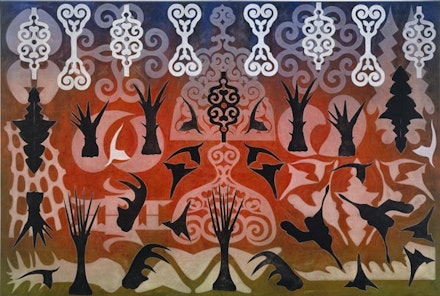
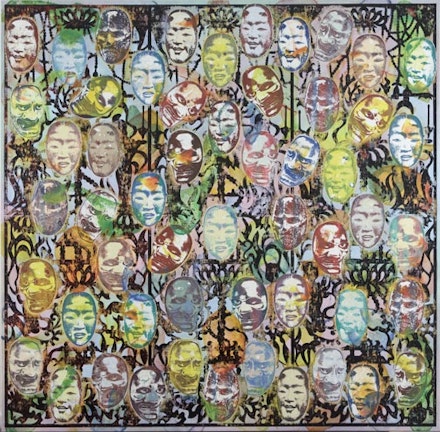
.jpg?w=440&q=80&fit=max)

